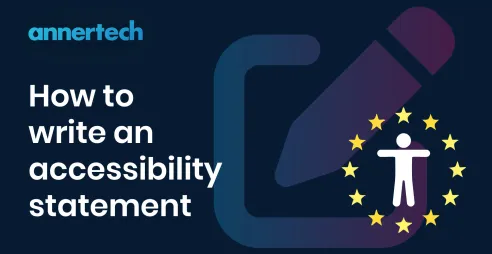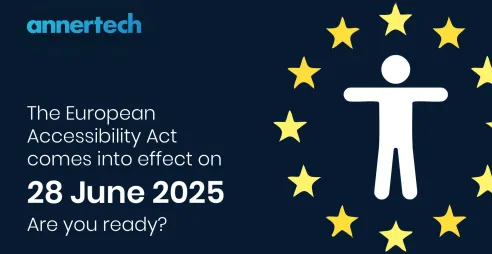The main issues affecting accessibility of local government websites

Accessibility is a critical requirement for any online platform, but it’s especially vital for those operated by the public sector, such as local governments, where essential services must be inclusive and available to everyone. But just how accessible are these digital services?
Public sector websites and mobile apps have to be accessible by law, so consistent monitoring is important to maintain high standards across the sector. This monitoring is done by national bodies, which set standards for the public sectors’ digital presence, and regularly check to see that the standards are being reached.
This monitoring process does get results. As the UK’s Government Digital Service (GDS), which is responsible for setting, leading and delivering the vision for a modern digital government, commented in its latest monitoring report: “Monitoring gets the public sector to fix their accessibility issues.”
The GDS’s monitoring of websites and apps from 2022 to 2024 found numerous issues, especially some major ones which we cover in more detail below. And the latest Monitoring 2022-2024 EU Web Accessibility Directive report from Ireland’s National Disability Authority (NDA) also flagged major issues, although it’s worth noting that both the GDS and NDA reported major improvements from one monitoring period to the next.
Major issues
Public sector websites in the UK
A number of issues are continuing to affect the accessibility of public sector websites. The top three issues highlighted by the GDS after simplified testing are:
- Colour contrast – These include not enough colour contrast between text and background, which makes it harder for people with visual impairments to read.
- Visible focus – A lack of visible focus affects the users of keyboards and screen readers, which can help people with visual impairments, cognitive, hearing and motor disabilities.
- Keyboard navigation – Another involves problems in using a website or app with a keyboard, which affects users who have trouble operating a pointing device such as a mouse, and screen reader users.
Public sector websites in Ireland
When it comes to the types of accessibility errors for local authorities in Ireland, the results are slightly different.
The most common errors are:
- PDFs – Inaccessible PDFs were the most common issue for the highest number of websites reviewed by the NDA in 2023 and 2024. Some of the challenges mentioned were low awareness of the errors among staff and low capacity among design agencies on creating accessible PDFs.
- Colour contrast – This is the same issue as the UK findings.
- Name, role, value – "Name, Role, Value" refers to the information that assistive technologies (like screen readers) use to understand and interact with user interface components, ensuring accessibility for users with disabilities.
We come across these issues on a regular basis when we conduct accessibility audits. These are also the issues that would affect the majority of people who are impaired in some way, so they’re important to get right, especially on public sector websites, which offer essential information and services to their users.
PDFs are going to remain a tricky beast for some time, especially as they seem to be favoured among many councils.
As the NDA noted: “While some local authorities have addressed many of the accessibility errors identified in their simplified review for HTML pages on their websites, the practice of publishing inaccessible PDFs will continue to be a challenge to reaching full compliance with the directive.”
About the monitoring
The GDS conducted simplified monitoring on 1,151 websites. Of the websites monitored, 10 had no accessibility issues. Half of the websites had 23 or fewer issues. The most issues found was 73. After sending the report, correspondence with the public sector organisations, and a retest after 12 weeks, 303 websites had fixed the issues found or had a short-term plan to fix remaining issues. This brought the compliance rate to 70%, which was slightly improved on the previous monitoring period (59%).
Similarly, the NDA conducted simplified reviews on 232 websites. An average of 330 pages were tested per site. Overall, 58.9% of pages were found to have no errors.
In the UK, 55.3% of accessibility issues found in monitoring were fixed by the public sector organisation. In Ireland, the percentage of pages with no errors detected by automated tools rose from 22.8% in October 2023 to 58.9% in October 2024.
This positive trend reflects the efforts made to address the errors identified through their simplified reviews.
It’s also worth noting that simplified tests are automated, only cover parts of Web Content Accessibility Guidelines (WCAG), and test on a small number of pages. But despite their limitations they are worth running – they flag common issues and they’re cost-effective.
Often you’ll find that there is one issue, for example colour contrast, that is repeated across the website. Fixing that single issue can drastically reduce the number of problems across all the pages.
Although it is possible to fix accessibility issues as they are identified in audits, it’s easier to solve accessibility issues right at the beginning, when a website is first being developed, throughout the delivery and beyond launch to avoid new issues being introduced.
Making council websites accessible
The GDS guidelines are followed by many sector leaders, including the LocalGov Drupal CMS - which, although it was started for councils in the UK, has been used by councils in Ireland too. Annertech has helped move a number of councils on to this platform, which is known for being accessible out-of-the-box.
This is because the LocalGov Drupal team champions and supports an accessibility-first approach to feature development.
As part of my work with the LocalGov Drupal (LGD) Accessibility Governance Group, I am currently involved with an extensive accessibility audit of the LGD platform.
One of our priorities is to continue with the LGD accessibility audit, and record the issues with recommendations and next steps so they can be addressed.
The group’s goal is to maintain LocalGov Drupal’s accessibility quality standards (it conforms to WCAG 2.2 (AA) and Authoring Tool Accessibility Guidelines (ATAG) 2.0) and also communicate important accessibility updates to the community, such as legal updates.
The benefits of accessibility aren’t limited to complying with regulations: an accessible website offers a better user experience for many more people, and search engines love accessible websites so it’s good for SEO too.
Our goal is to ensure that everyone who visits a website that we have developed or currently maintain gets a great experience, no matter the challenges they face in real life.
We are determined to make the web as inclusive as possible, and building accessibility into websites from the beginning is the best way to ensure that that happens.

How accessible is your website?
If it’s been a while since your website underwent an accessibility audit then it’s definitely time for a new one.
Get in touch


